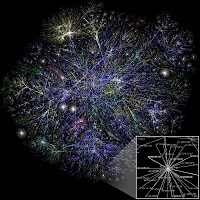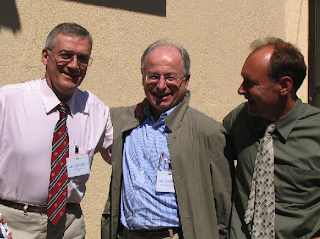Andrea Palladio, Italian architect, birthday 30 November 1508
Crystal Palace, Hyde Park/Penge Common, London, England, destroyed by fire 30 November 1936
Minoru Yamasaki, American architect, birthday 1 December 1912
 To the general public, the name Palladio usually refers to a
Palladian style window: an arched top window flanked by matching rectangular
ones. But to the architecture community
the image of the nearly perfectly symmetrical Villa Almerico-Capra (a.k.a.
Villa Rotunda) comes to mind. Palladio’s
life long search desire to achieve symmetry was influenced by classical
architecture after being exposed to Vitruvius’ Seven Books on Architecture and
inspired him to write four more of his own.
In the Renaissance, artists were searching antiquity to regain the
symbolic knowledge lost during the Dark Ages.
Palladio used classical Roman hierarchies to create a new building type, the agricultural villa, but used inexpensive building materials such as stucco covered brick.
To the general public, the name Palladio usually refers to a
Palladian style window: an arched top window flanked by matching rectangular
ones. But to the architecture community
the image of the nearly perfectly symmetrical Villa Almerico-Capra (a.k.a.
Villa Rotunda) comes to mind. Palladio’s
life long search desire to achieve symmetry was influenced by classical
architecture after being exposed to Vitruvius’ Seven Books on Architecture and
inspired him to write four more of his own.
In the Renaissance, artists were searching antiquity to regain the
symbolic knowledge lost during the Dark Ages.
Palladio used classical Roman hierarchies to create a new building type, the agricultural villa, but used inexpensive building materials such as stucco covered brick.  The Venetian aristocracy
of the time ate it up. These imposing
structures lorded over their sites creating a sense of superiority. This would later influence the American
plantation designers where the main house used neoclassical designs and
plantation owners attempted to establish their dominance as a new
aristocracy.
The Venetian aristocracy
of the time ate it up. These imposing
structures lorded over their sites creating a sense of superiority. This would later influence the American
plantation designers where the main house used neoclassical designs and
plantation owners attempted to establish their dominance as a new
aristocracy.  At the height of the Victorian Period and the Industrial
Revolution, Great Britain sought to hold the world’s first international
exhibition. To accompany the effort, the
committee organizers called for designers to submit plans for an exhibition
building that was cheap, easy to construct and temporary. Nearly 250 were submitted but none fulfilled
the requirements. One of the committee
members sought out the head gardener at Chatsworth House, Joseph Paxton.
At the height of the Victorian Period and the Industrial
Revolution, Great Britain sought to hold the world’s first international
exhibition. To accompany the effort, the
committee organizers called for designers to submit plans for an exhibition
building that was cheap, easy to construct and temporary. Nearly 250 were submitted but none fulfilled
the requirements. One of the committee
members sought out the head gardener at Chatsworth House, Joseph Paxton.  He had been experimenting with greenhouse
designs and the new, inexpensive and strong manufactured cast plate glass. Paxton’s idea of using the manufacturer’s
off-the-shelf materials as the basis of the building unit-scale and
construction not only saved money, it saved time. The subsequent design was not only larger
than any of the other submissions; it was way under budget and on time.
He had been experimenting with greenhouse
designs and the new, inexpensive and strong manufactured cast plate glass. Paxton’s idea of using the manufacturer’s
off-the-shelf materials as the basis of the building unit-scale and
construction not only saved money, it saved time. The subsequent design was not only larger
than any of the other submissions; it was way under budget and on time.  The enormous 1,851 foot long structure
enclosed over 19 acres of parkland and was adapted to save existing trees to be
chopped down (a point of contention to those opposed to the entire production). This enormous “erector” set was easily
dismantled after the Great Exhibition of 1851 and relocated to a park elsewhere
in the city. Unfortunately, little was
known about fire safety at that time.
When a small fire started in the women’s coat room it quickly spread to
the entire edifice and turned the night sky red visible for eight
counties.
The enormous 1,851 foot long structure
enclosed over 19 acres of parkland and was adapted to save existing trees to be
chopped down (a point of contention to those opposed to the entire production). This enormous “erector” set was easily
dismantled after the Great Exhibition of 1851 and relocated to a park elsewhere
in the city. Unfortunately, little was
known about fire safety at that time.
When a small fire started in the women’s coat room it quickly spread to
the entire edifice and turned the night sky red visible for eight
counties.  Minoru Yamasaki’s polite quiet demeanor was at odds with the
brutal “New Formalism” buildings he designed.
Although, it is for the controversial design of the Twin Towers in New
York City Yamasaki is most remembered, it was the Pacific Science Center in the
shadow of the Seattle Space Needle that first gained him international praise
and the cover of Time magazine in 1963. The metal lace of the PSC’s gothic pointed vaults was carried over to the purely decorative base of the WTC. Yamasaki was on the forefront of the postmodernist movement which made his designs an easy target for criticism.
Minoru Yamasaki’s polite quiet demeanor was at odds with the
brutal “New Formalism” buildings he designed.
Although, it is for the controversial design of the Twin Towers in New
York City Yamasaki is most remembered, it was the Pacific Science Center in the
shadow of the Seattle Space Needle that first gained him international praise
and the cover of Time magazine in 1963. The metal lace of the PSC’s gothic pointed vaults was carried over to the purely decorative base of the WTC. Yamasaki was on the forefront of the postmodernist movement which made his designs an easy target for criticism.  Many referred to the Twin
Towers as giant metal file cabinets (and I agree). However, with their collapse and all the
lives taken with them, it is hard not to look at the New York skyline and be
reminded of their absence. This
undoubtedly placed them in a more loving corner of the general population’s
hearts. After all the controversy,
Yamasaki went on to design the similar Rainier Tower in Seattle which seemed to
put the “file cabinet” on a pedestal.
Perhaps this was a figurative thumbing his nose at the critics.
Many referred to the Twin
Towers as giant metal file cabinets (and I agree). However, with their collapse and all the
lives taken with them, it is hard not to look at the New York skyline and be
reminded of their absence. This
undoubtedly placed them in a more loving corner of the general population’s
hearts. After all the controversy,
Yamasaki went on to design the similar Rainier Tower in Seattle which seemed to
put the “file cabinet” on a pedestal.
Perhaps this was a figurative thumbing his nose at the critics.
Links:







.JPG)
.JPG)












